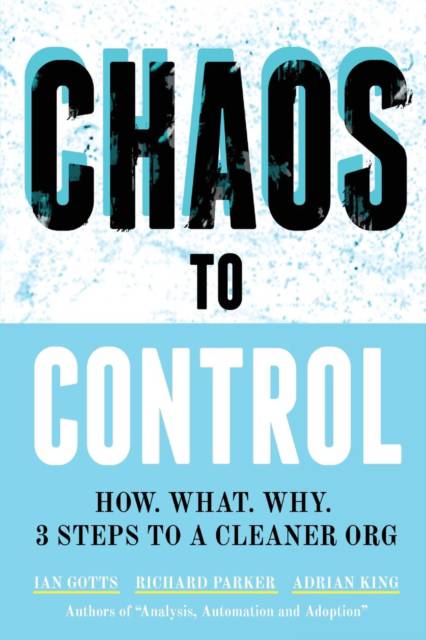
- Retrait gratuit dans votre magasin Club
- 7.000.000 titres dans notre catalogue
- Payer en toute sécurité
- Toujours un magasin près de chez vous
- Retrait gratuit dans votre magasin Club
- 7.000.0000 titres dans notre catalogue
- Payer en toute sécurité
- Toujours un magasin près de chez vous
Chaos to Control
How. What. Why. 3 Steps to a Cleaner Org
Ian Gotts, Richard Parker, Adrian KingDescription
The phrase "Salesforce@scale Dilemma" was coined by Forrester, the industry analysts.
Internal success in an organization breeds demand for more and more. The complexity of scale then crushes Salesforce's responsiveness. As Salesforce use grows, innovation slows, and flexibility evaporates. Why? Every app change risks breaking one of hundreds of data and process customizations, integration links, and third-party add-ons. The Salesforce@scale dilemma is a challenge for customers to overcome, not an inevitable outcome of a Salesforce implementation.
What Admins and Consultants have been searching for is a simple, easily implemented and repeatable approach for cleanup and documentation. It also needs to work for new builds, no matter the size or complexity of Org. And it must be sustainable as the Org evolves.
Where do you start with an Org that has 20,000+ meta data items? Our HOW. WHAT. WHY. approach is simple, practical and achievable. It takes an operational perspective to help clean up and document an Org. But it is also the approach to keep an Org well documented, so the Salesforce@scale issues do not kick in.
Whilst the approach can be delivered with spreadsheets, the field analysis is massively time consuming, and the config documentation proves almost impossible to maintain.
This is why we've spent the last 3 years building Elements Catalyst. It is an app specifically designed to support Admins and Consultants to deliver Salesforce projects more effectively. It has enterprise scalability and security built in and it is architected to work with the most complex Orgs with multiple Production and Sandboxes. The powerful analysis helps accelerate clean-up efforts and it becomes the central source of all documentation and collaboration for the Org.
A key driver for many organizations is migration to Lightning. This is a significant project which needs careful planning and analysis. The book looks at this specific use case and shows how the approach dovetails with the best practice advice from Salesforce and their experience of migrating their largest internal Org - Org62.
The benefits of moving to Lightning are huge. Salesforce's own research of over 500 companies who had made the switch makes compelling reading; 31% less time managing pipe and 28% less time standardizing processes, with 21% uplift in win rates, 29% faster reporting, 40% improved collaboration, and 41% higher productivity.
Therefore, anything that can accelerate migration must be seriously considered. The first phase of the Lightning Experience Rollout is "Discover" which requires an understanding of what has been configured, a reassessment of business processes to exploit the new Lightning functionality, and a clean-up of the Org.
The approach can deliver tangible savings in this phase. But embedding the good habits means that new Lightning configurations that need to be built to support the migration are well documented. This builds a strong foundation for future enhancements.
The final critical part in the migration is strong change management to drive up user adoption. The existing documentation can be reused as training material, embedded in the new Lightning pages. Any fine tuning to incorporate user feedback is easily implemented. The approach and Elements Catalyst app provide a very powerful combination to help mitigate the Salesforce@scale Dilemma, so that Salesforce potential is not limited by its own success.
Spécifications
Parties prenantes
- Auteur(s) :
- Editeur:
Contenu
- Nombre de pages :
- 110
- Langue:
- Anglais
Caractéristiques
- EAN:
- 9781907453250
- Date de parution :
- 22-04-19
- Format:
- Livre broché
- Format numérique:
- Trade paperback (VS)
- Dimensions :
- 156 mm x 234 mm
- Poids :
- 163 g

Les avis
Nous publions uniquement les avis qui respectent les conditions requises. Consultez nos conditions pour les avis.






